1. AI Transformation for Fashion Brands
In recent years, change clothes AI has transformed the way fashion brands, retailers, and designers create product visuals. This technology enables instant outfit changes in photos without the need for re-shoots, making it a powerful alternative to traditional methods. As the fashion and e-commerce industries face mounting pressure to produce more content in less time, AI-driven tools are becoming an essential part of the workflow.
The conventional approach to product imagery—hiring models, arranging photo shoots, and producing multiple outfit combinations—comes with high costs and long turnaround times. For online retailers, there’s also the added challenge of managing large inventories, capturing each garment on various body types, and localizing visuals for different markets. These steps not only require significant resources but also slow down product launches.
PiktID offers a cost-effective, scalable solution to these challenges. By using change clothes AI, businesses can instantly visualize garments on any model, adjust styles in real time, and maintain high-quality, realistic results. Whether it’s updating product catalogs, testing new designs, or creating marketing visuals, this approach reduces both expenses and production time—allowing brands to keep pace with fast-changing trends.
2. What is Change Clothes AI?
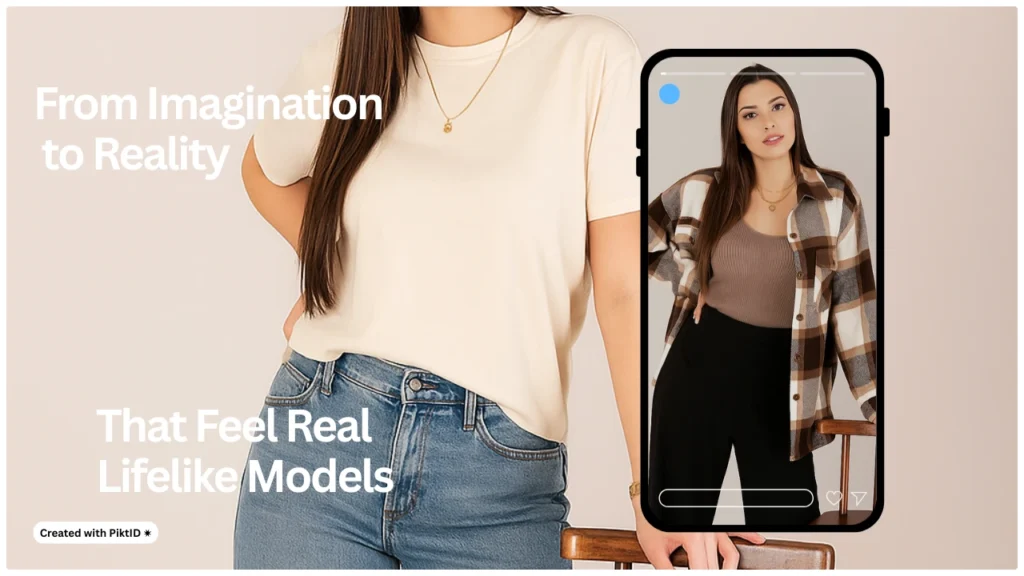
AI Clothes Changer is an advanced technology that allows users to digitally swap outfits on images of real people or models. Unlike basic photo-editing tools, it uses artificial intelligence to ensure the new clothing blends seamlessly with the subject’s body and environment.
Here’s how it works:
- Outfit Overlay: The garment image is positioned onto the model’s photo with precise alignment.
- Fit Adjustment: AI detects body shape and pose to ensure the clothing fits naturally.
- Texture Mapping: Fabric details such as folds, seams, and patterns are preserved for authenticity.
- Lighting Integration: Shadows, highlights, and ambient light are matched so the clothing looks like it was photographed in the original scene.
One of the main advantages of change clothes AI is its ability to maintain realism. Fabric drapes follow the contours of the body, shadows fall in the right places, and proportions remain accurate—eliminating the “cut-and-paste” look of older editing techniques. For brands, this means delivering professional-grade visuals that are indistinguishable from real photo-shoots, but with a fraction of the effort and cost.
3. Key Benefits for Fashion Websites (B2B)
For fashion brands and marketplaces that need to produce large volumes of product imagery, change clothes AI technology offers a transformative solution. Instead of organizing costly photo-shoots for every garment variation, businesses can instantly create high-quality visuals that match their branding and seasonal collections.
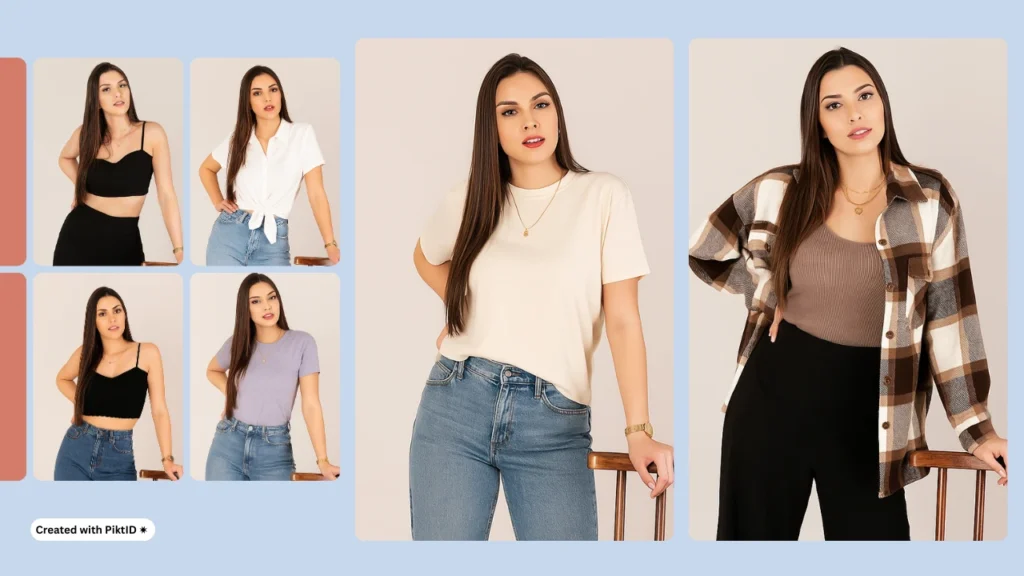
a. Scalable Content Production
- Generate hundreds or even thousands of outfit variations without manual editing.
- Ideal for brands with large catalogs or those updating collections frequently.
- Consistency in lighting, model poses, and framing ensures a professional and cohesive look across all listings.
b. Global Audience Localization
- Tailor clothing visuals to align with cultural preferences and seasonal trends in different markets.
- Replace garments in images to showcase region-specific colors, fabrics, and styles.
- This approach supports international campaigns without the logistical costs of global photo-shoots.
c. Inventory Flexibility
- Display designs and product variations before physical production is complete.
- Test multiple colorways or styles digitally, gathering feedback before committing to manufacturing.
- Reduce overproduction by only producing items that generate strong interest.
d. Cost Efficiency
- Minimize expenses on model hiring, photographer fees, and studio rentals.
- Lower the need for multiple photo-shoots for each variant, freeing up budget for marketing or product development.
- Change clothes AI solutions make it possible to refresh a product catalog at a fraction of the traditional cost.
You can also create a realistic model based on our guide about, how to create an AI influencer.
4. Key Benefits for E-Commerce Stores (D2C)
For direct-to-consumer online stores, Change Clothes AI is not just about saving time—it’s about enhancing the shopping experience. It enables highly personalized, dynamic, and conversion-driven visuals that help customers make confident purchase decisions.
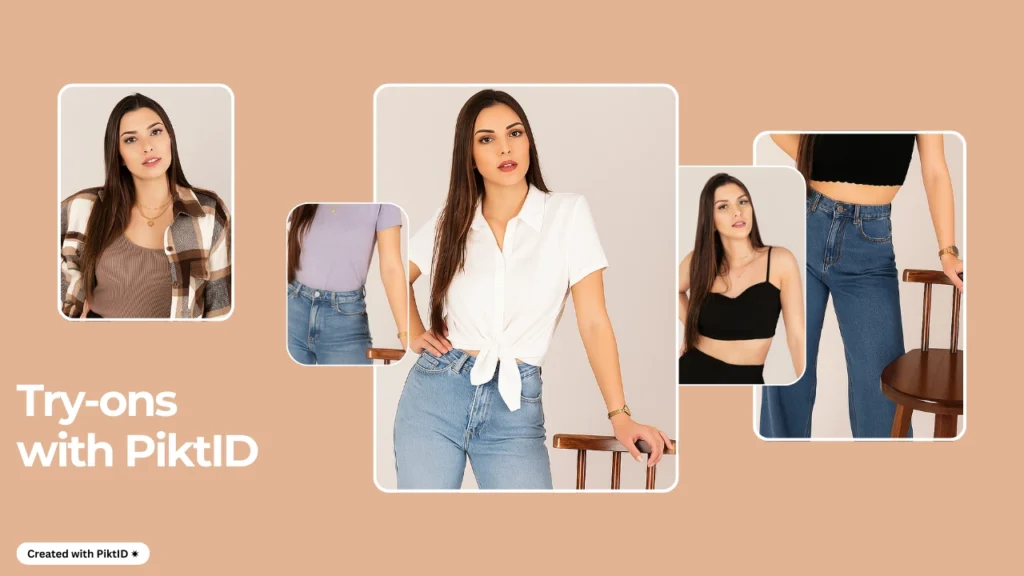
a. Virtual Try-On Experiences
- Allow customers to see how different outfits look on a model in real-time.
- Boost buyer confidence and reduce returns by showing accurate garment fit and drape.
- Enhance mobile and web shopping experiences with interactive clothing previews.
b. A/B Testing Product Visuals
- Quickly test different colors, patterns, and styles to see which performs best in sales or engagement.
- Swap garments in images instantly without having to shoot new photos.
- Data-driven insights can inform future design and merchandising decisions.
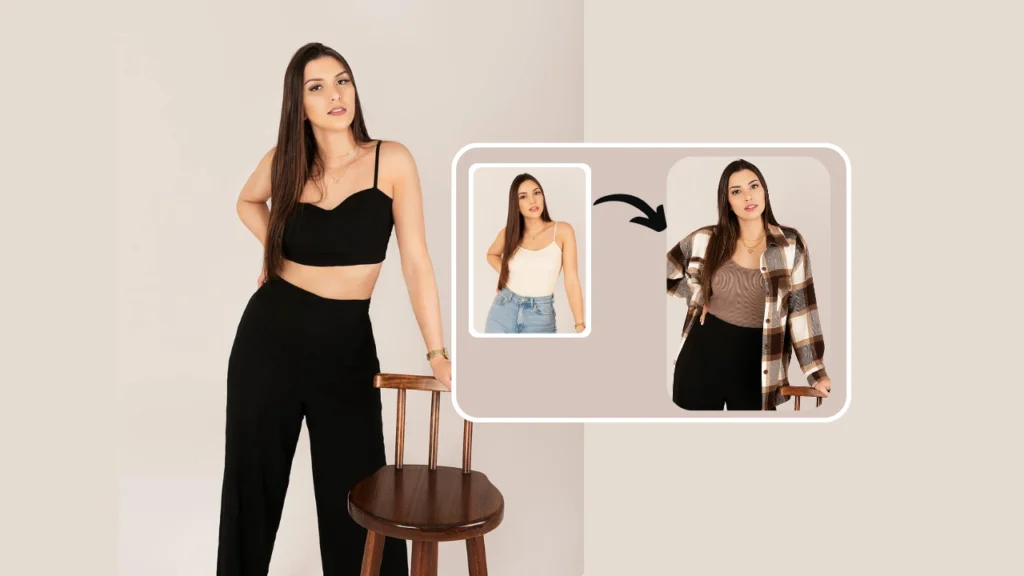
c. Rapid Seasonal Updates
- Prepare holiday-themed visuals, summer collections, or limited-edition drops instantly.
- Keep product listings fresh and aligned with fast-moving fashion trends.
- Change clothes AI ensures that updates are consistent in quality and branding.
d. Size-Based Customization
- Showcase how garments look on different body types without scheduling multiple photo-shoots.
- Offer more inclusive and relatable visuals for diverse audiences.
- Adapt product images for various size ranges to better connect with shoppers.
Read more: AI Generated Male Model
5. How PiktID’s Change Clothes AI Works
PiktID’s change clothes AI has been designed to make virtual outfit swapping both highly realistic and remarkably easy. The technology combines advanced computer vision with garment simulation models to ensure that every result looks authentic, down to the smallest fabric detail. Here’s how the process works:
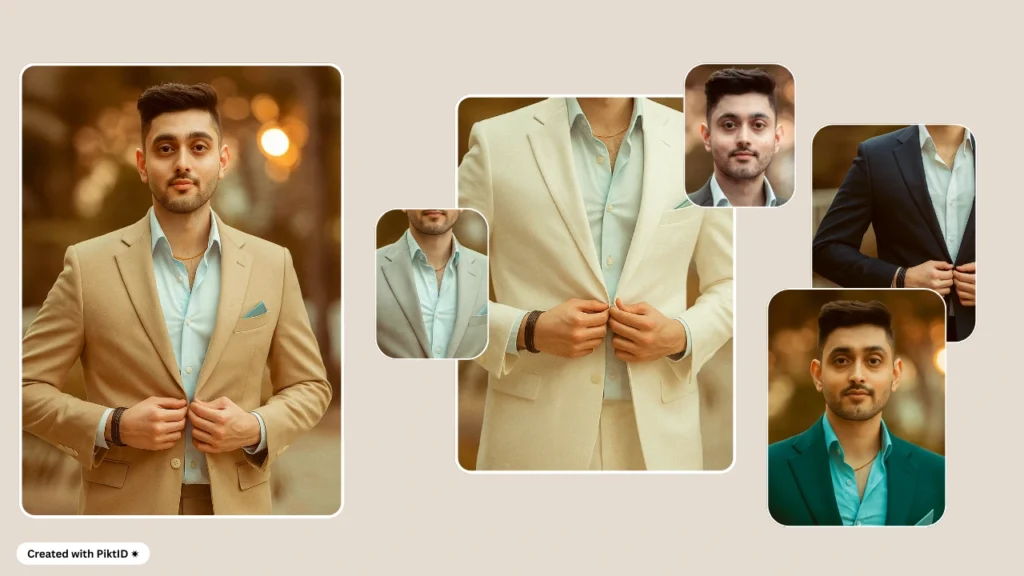
Step 1: Upload the Base Photo
You begin by uploading a high-quality image of your model, customer, or influencer. PiktID’s AI automatically detects the body outline, pose, and proportions to prepare for accurate garment placement.
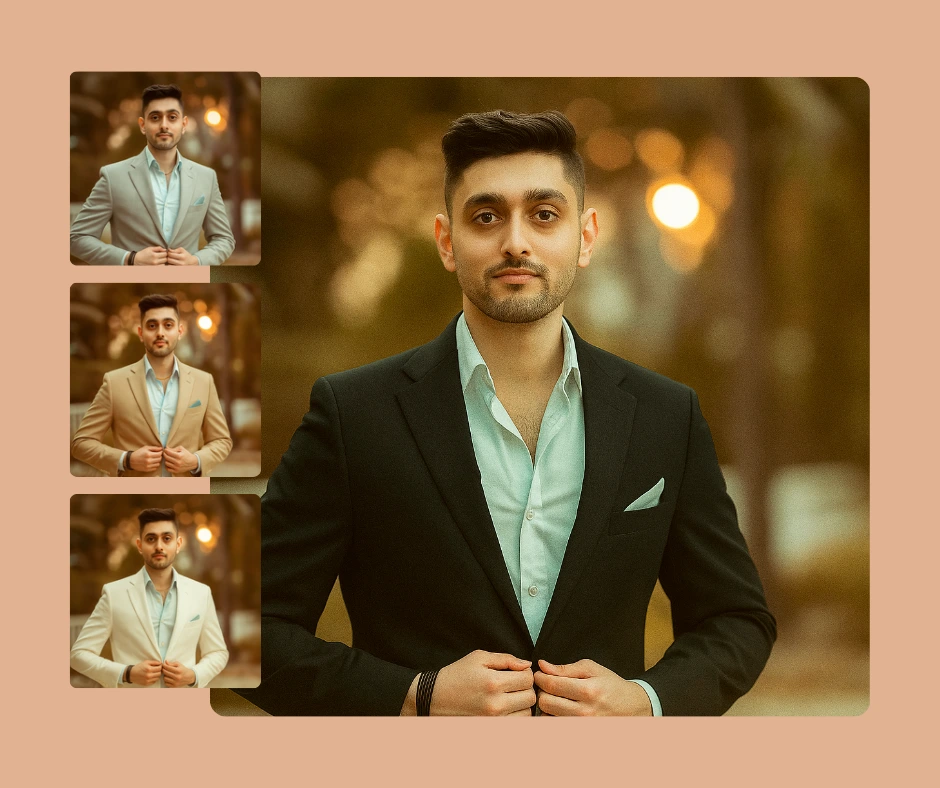
Step 2: Select or Upload the Clothing Item
Choose from your existing product catalog or upload a new garment image. The system identifies key garment features, such as neckline, sleeve length, and hemline, to ensure proper alignment.
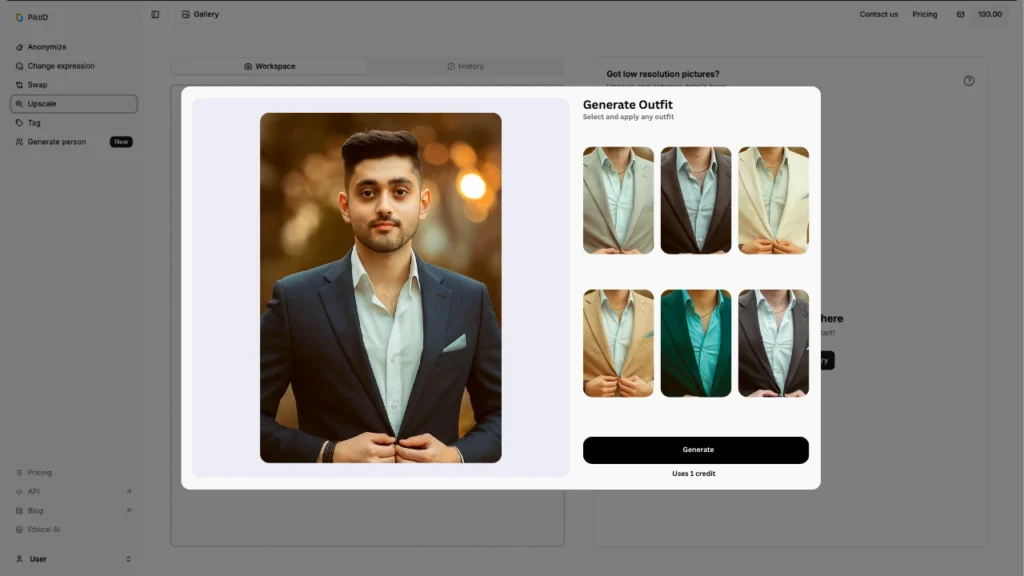
Step 3: AI Adjusts Fit, Texture, and Lighting
The change clothes AI processes the image to map the garment onto the subject’s body. It preserves the original fabric texture, replicates wrinkles for realism, and blends natural shadows seamlessly. Advanced lighting correction ensures that the new clothing matches the lighting conditions of the base image, eliminating any “pasted on” look.

Step 4: Download or Publish Instantly
Once the rendering is complete, you can download a high-resolution image for marketing, product pages, or social media. The output is ready for professional use without requiring additional manual edits.
Key Strengths of PiktID’s Technology:
- Accurate preservation of fabric patterns and weave
- Realistic wrinkle and drape simulation
- Consistent blending of shadows and highlights
- Scalable results for single images or large product batches
This workflow allows brands to adapt, experiment, and deploy visual content at speeds impossible with traditional photo-shoots, making PiktID a valuable asset for fast-moving fashion businesses.
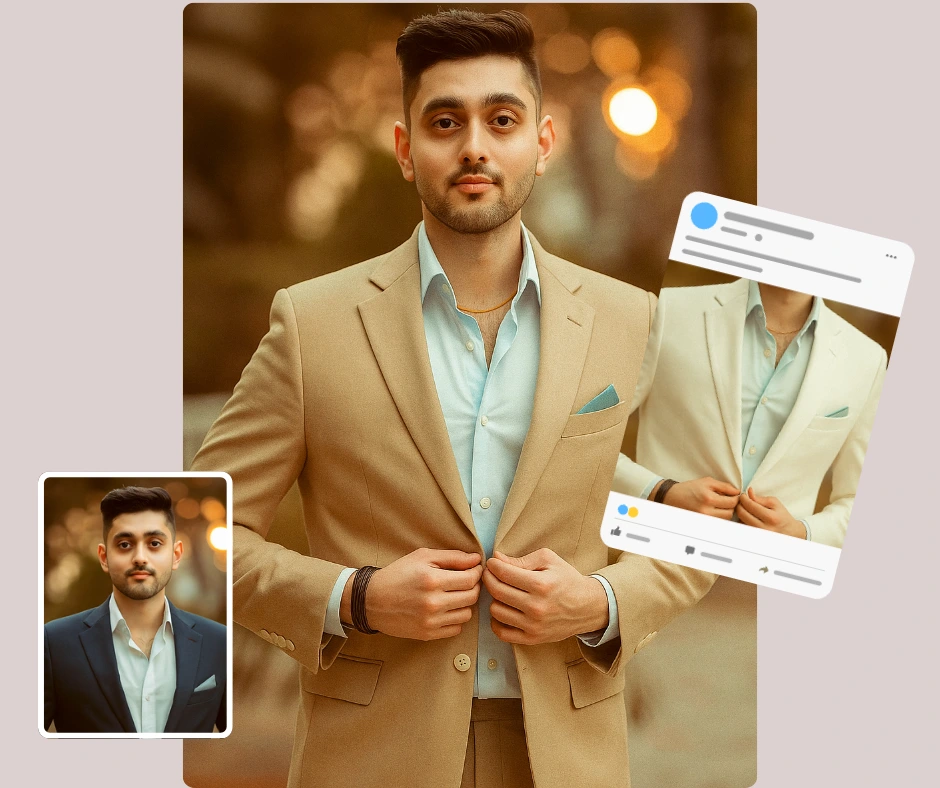
6. Best Ways to Take Advantage of PiktID’s Change Clothes AI
PiktID’s change clothes AI isn’t just a tool for digital editing—it’s a flexible solution for transforming how brands, retailers, and creators produce clothing visuals. Here are some of the most effective ways to use it:
i. Pre-Launch Marketing
Showcase new collections before physical samples are available. Designers can generate model shots instantly, ensuring campaigns launch on time and with consistent styling.
ii. Cross-Selling Opportunities
From a single model photo, create multiple outfit variations to promote complementary products. This boosts average order value and lets customers visualize more complete looks.
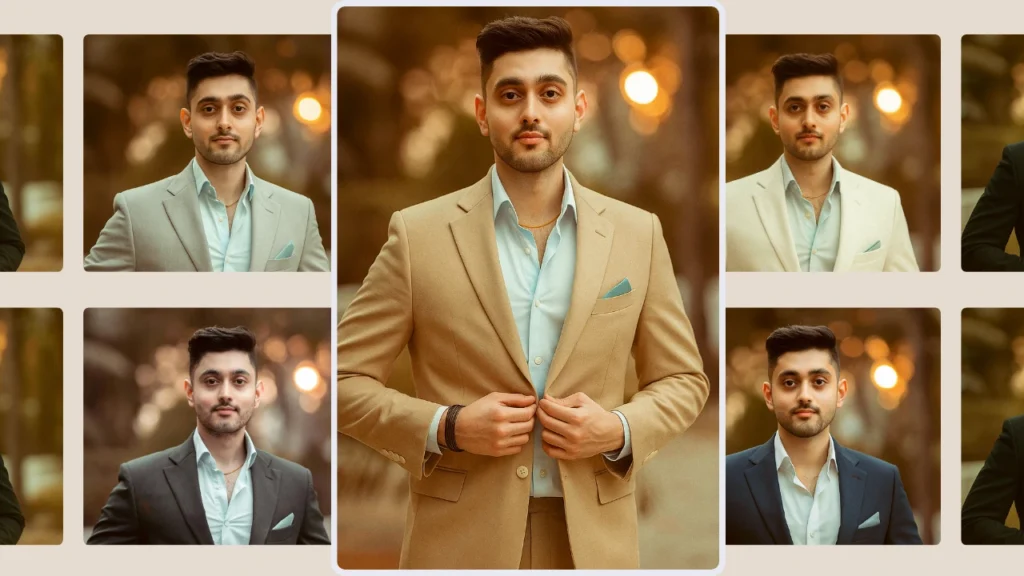
iii. Localized Product Pages
Adapt product imagery to match regional preferences without organizing new photo-shoots. Whether it’s seasonal adjustments or cultural styling, the change clothes AI allows quick localization.
iv. Influencer Content Scaling
Equip influencers with high-quality visuals of your products without requiring physical samples. This is ideal for rapid campaign rollouts and international influencer partnerships.
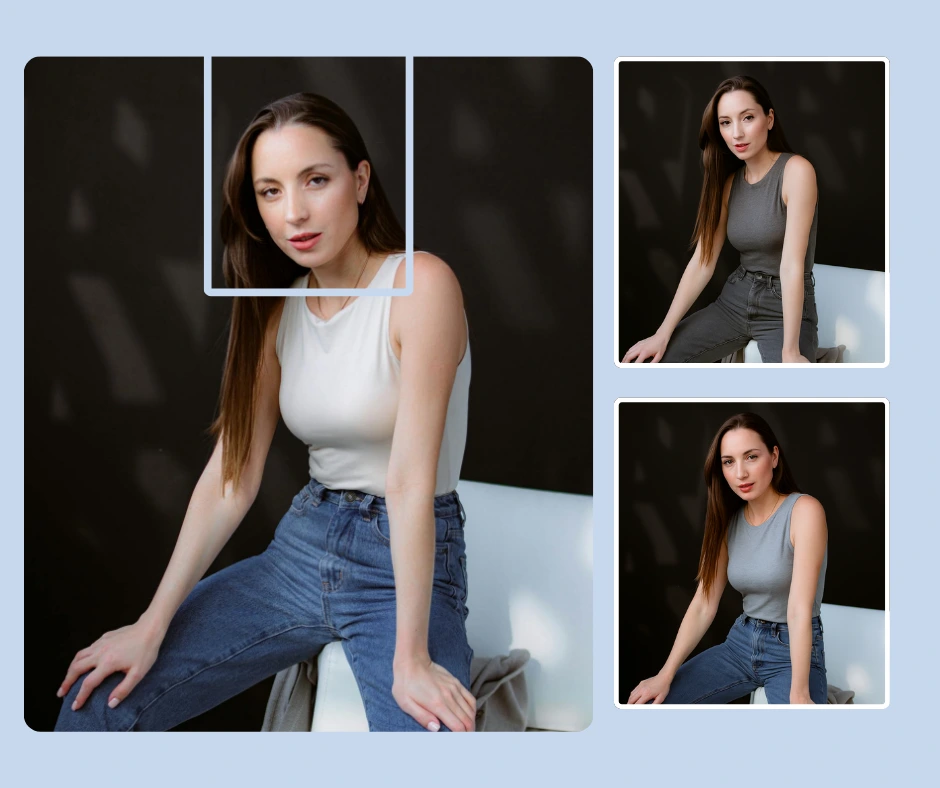
v. Virtual Fitting Rooms
Integrate the change clothes AI into your e-commerce platform to help customers see products on different body types or on their own uploaded photos. This increases buyer confidence and can significantly reduce returns.
Why It Works:
- Reduces production time from weeks to minutes
- Keeps visual branding consistent across channels
- Enables rapid experimentation with styles, colors, and garment pairings
- Supports both small-batch boutique brands and large-scale retail catalogs
By leveraging these strategies, businesses can maximize the creative and commercial potential of PiktID’s Body Swap AI, ultimately achieving faster time-to-market and richer customer engagement.
7. Real-World Use Cases
The ability to change clothes AI-powered technology is transforming the way fashion brands, retailers, and content creators produce and display apparel. Instead of relying solely on time-consuming photoshoots, businesses can now instantly preview, adapt, and publish product visuals with unmatched speed and flexibility.
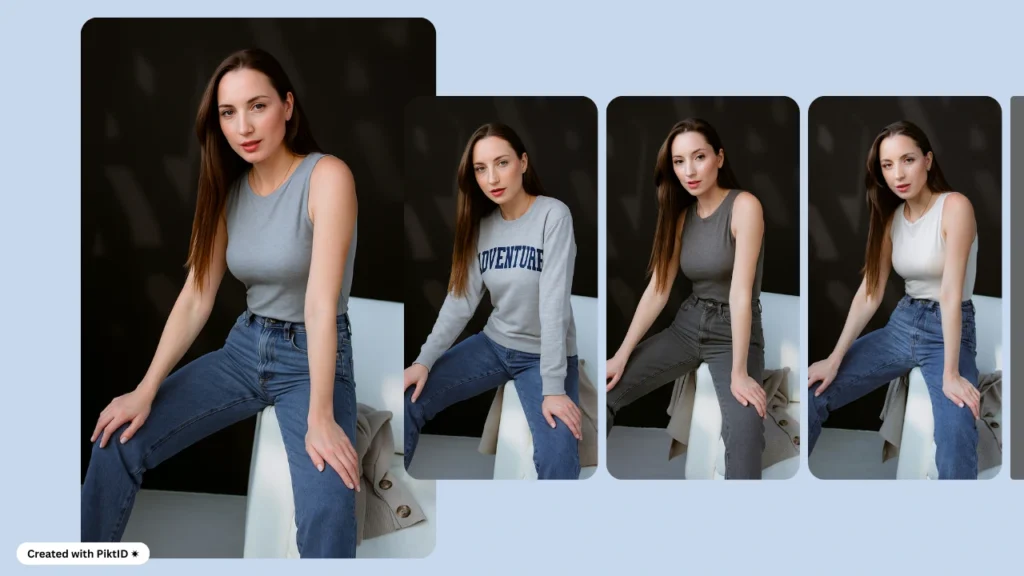
i. Fashion Marketplaces
Large online fashion marketplaces such as Zalando and ASOS already use AI-driven outfit previews to give customers a more immersive shopping experience. With change clothes AI solutions like PiktID, these platforms can:
- Display the same garment on multiple models with varying body types.
- Instantly adapt clothing visuals for different regions or cultural styles.
- Reduce the need for res-hooting seasonal collections.
ii. Small D2C Brands
For small direct-to-consumer fashion labels, budgets and timelines can be tight. By using change clothes AI tools, these brands can:
- Create entire seasonal catalogs in just a few days instead of months.
- Test multiple styles, colors, and fits without producing physical samples.
- Achieve professional-quality visuals without expensive studio setups.
iii. Event Merchandise Sellers
Merch sellers for concerts, festivals, and sports events can benefit greatly from this technology. Instead of printing large batches and hoping they sell, they can:
- Preview how merchandise looks on different models before committing to production.
- Quickly create marketing visuals tailored to different audience segments.
- Update designs in real time for special editions or limited releases.
Across all these cases, change clothes AI technology reduces production costs, shortens lead times, and offers flexibility that traditional workflows cannot match. This makes it a powerful tool not just for big names in fashion, but for any business looking to modernize its visual content strategy.
Additional Resource: PiktID’s Insert Face.
8. Comparison: AI Clothes Swap vs. Traditional Photo-shoots

When comparing traditional photography to AI-driven garment replacement, the advantages of using PiktID becomes clear. Beyond speed and cost savings, it also provides creative possibilities that physical shoots simply can’t replicate.
| Feature / Metric | AI Clothes Swap | Traditional Photoshoot |
| Cost per Outfit | Low – minimal production costs | High – studio, staff, models |
| Time to Market | Hours – instant processing | Weeks – from shoot to editing |
| Size & Body Type Variations | Unlimited – easily adaptable | Limited to available models |
| Global Styling Adaptation | Instant – adjust colors or styles for regions | Requires reshoot |
| Consistency Across Images | High – AI maintains lighting and alignment | Variable – depends on shoot |
Why AI Has the Edge
- Scalability: With change clothes AI, a single garment can be visualized on hundreds of model variations in minutes.
- Market Responsiveness: New trends or customer requests can be addressed instantly without scheduling a photoshoot.
- Sustainability: Eliminates the waste associated with producing unnecessary samples and transporting them for shoots.
- Creative Freedom: Designers can experiment with patterns, textures, and colors without incurring additional costs.
In short, while traditional photo-shoots still have a place for certain high-end editorial work, the flexibility, cost efficiency, and speed of PiktID’s AI make it an essential tool for modern fashion production and marketing workflows.
Feel Free to try out our AI image extender, to enhance any images.
9. Getting started with PiktID Studio
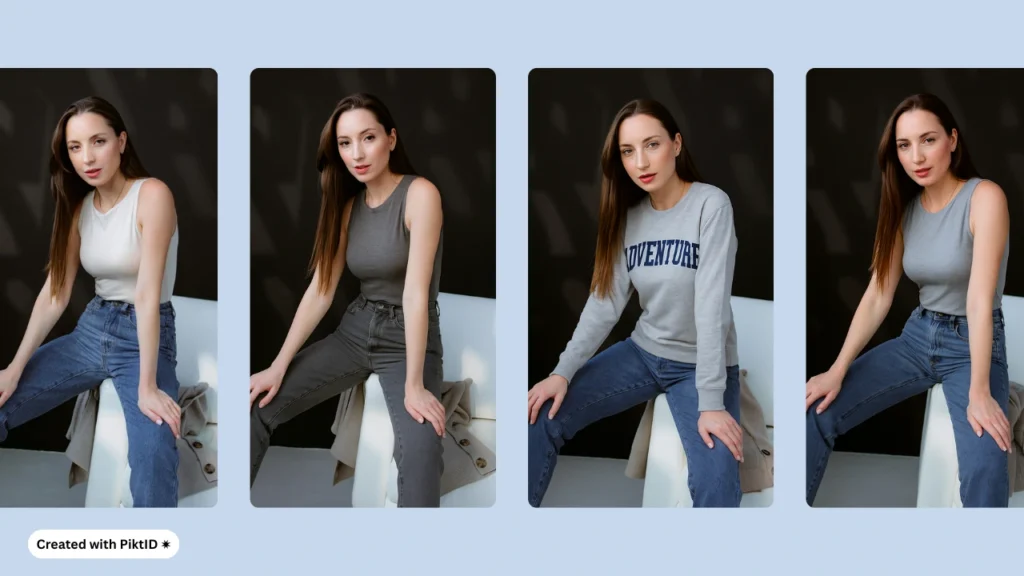
The rise of change clothes AI is reshaping how the fashion industry and e-commerce platforms create, test, and present their content. In the past, showing a product in multiple styles or on different models required costly photoshoots, significant editing work, and complex logistics. With modern AI technology, particularly PiktID’s platform, this process is now reduced to seconds.
One of the key benefits lies in cost savings. Brands no longer need to produce multiple physical samples for every color or variation. Instead, a single garment image can be digitally adapted to a variety of models, body shapes, and settings. This dramatically cuts production expenses and eliminates the need for repetitive photography sessions.
Scalability is another advantage. For e-commerce retailers managing hundreds or even thousands of SKUs, change clothes AI enables instant batch processing, allowing entire product catalogs to be updated seasonally or for special promotions without overwhelming creative teams. This scalability also extends to global markets—garments can be localized to suit different cultural aesthetics without creating separate shoots for each region.
From a customer experience perspective, the ability to instantly see an item on different body types, skin tones, and contexts builds confidence in purchasing decisions. Customers are more likely to engage with products when they can visualize how the clothing will actually look on them, leading to reduced returns and higher satisfaction rates.
Ultimately, PiktID is not just a technological upgrade—it’s a shift in how fashion brands think about design, marketing, and customer engagement. By merging creativity with efficiency, tools like PiktID enable both emerging designers and established retailers to compete at a higher level, deliver personalized experiences, and keep pace with the evolving demands of modern shoppers.
Read more: How to create AI model girl
10. Try PiktID to Change Clothes using AI
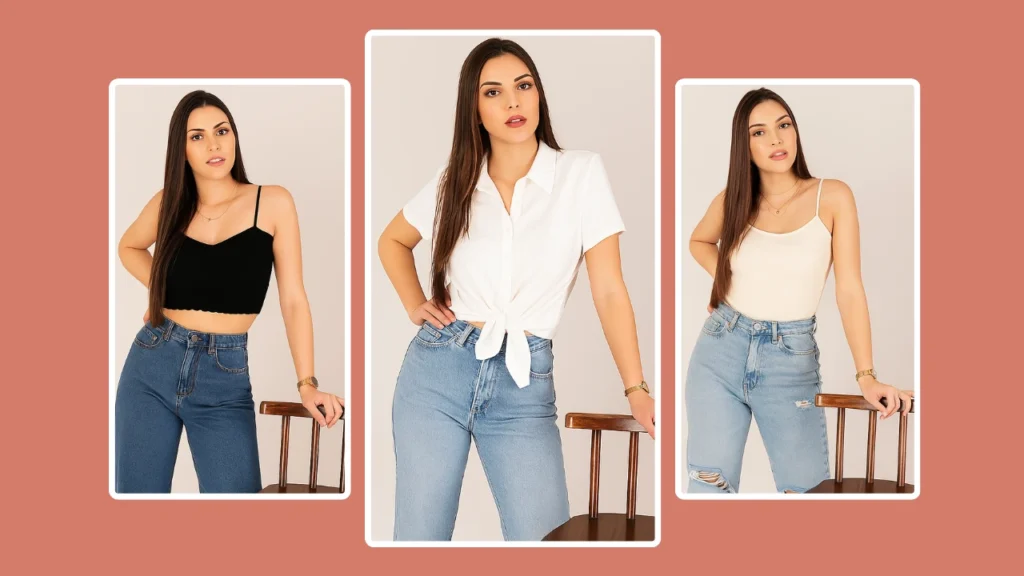
The future of digital fashion content is already here, and it’s powered by change clothes AI. If you’re ready to streamline your workflow, cut production costs, and create dynamic, personalized visuals for your audience, PiktID makes it simple to get started.
Whether you’re a designer showcasing your latest collection, an e-commerce store owner building seasonal lookbooks, or a developer integrating advanced virtual try-on features, PiktID’s Change Clothes AI tool is designed to fit seamlessly into your process. You can access it directly through our intuitive Studio interface or integrate it into your own platform via API for automated, large-scale operations.
To make it even easier for first-time users, PiktID offers 10 free credits so you can experience the power of change clothes AI without any upfront commitment. Experiment with outfit swaps, test product variations, or create marketing-ready visuals in just a few clicks.
Start today and see how quickly you can transform your product imagery into something truly engaging.
Try PiktID’s Change Clothes AI Tool and explore the possibilities of instant outfit transformations.
11. FAQs
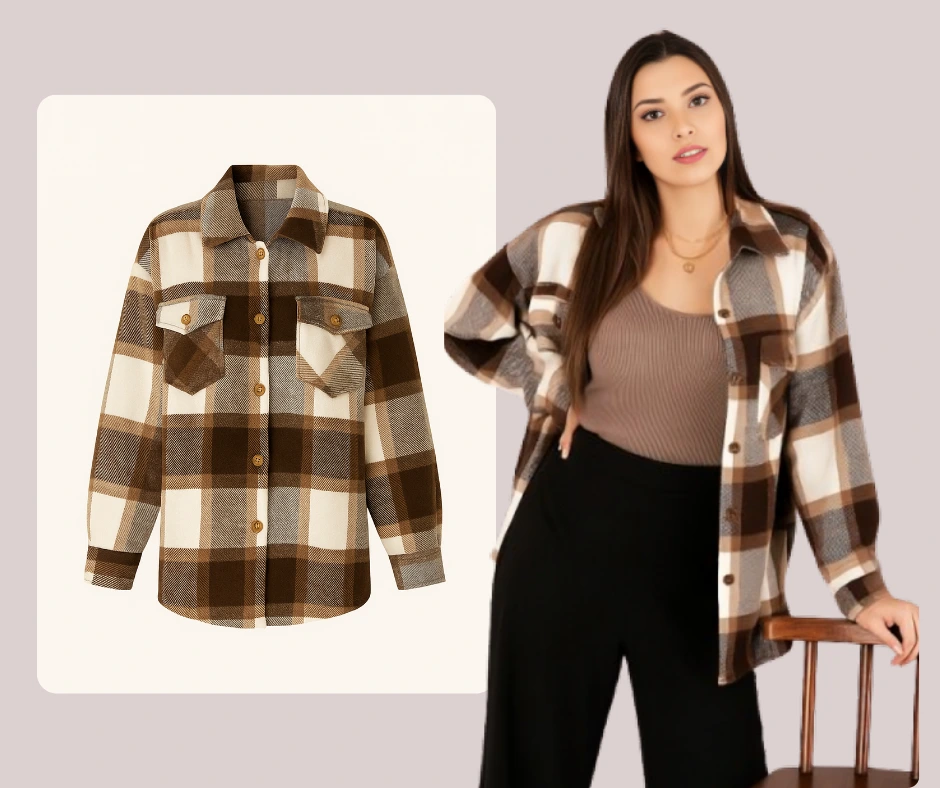
Q1: What is change clothes AI in fashion?
Change clothes AI is technology that uses artificial intelligence to digitally replace clothing on a model or person in an image, allowing instant outfit changes without new photo-shoots.
Q2: Can PiktID’s tool work with customer-uploaded photos?
Yes, users can upload personal photos, and the AI will adapt the clothing swap to fit the subject naturally.
Q3: Does it support different body sizes?
Absolutely. The system can adapt garments to different proportions, ensuring realistic fit across body types.
Q4: How realistic are the outfit textures?
PiktID’s algorithms preserve fine fabric details, lighting, and shadows so the final image appears as if the garment was actually worn.
Q5: Can I integrate it into my e-commerce store via API?
Yes, PiktID offers an API that enables direct integration for automated outfit changes on your platform.
Q6: How secure is my uploaded content?
All uploads are processed securely, and data protection measures ensure images remain private.
Q7: Can I preview seasonal outfits before production?
Yes, you can visualize new collections digitally before creating physical samples.
Q8: Is coding knowledge required?
No, the Studio tool is code-free, though developers can leverage the API for advanced integrations.

